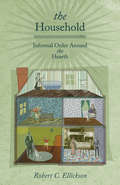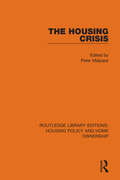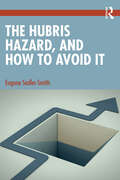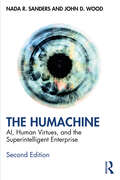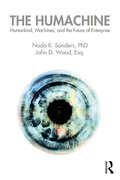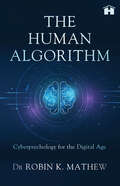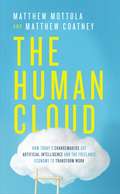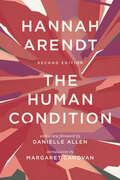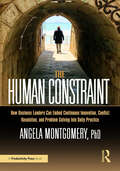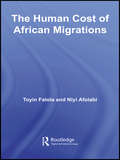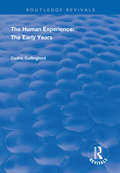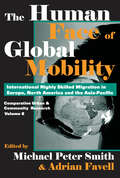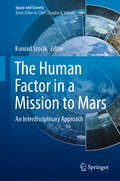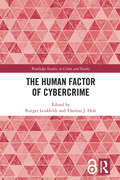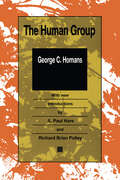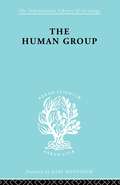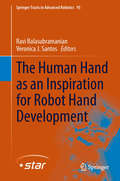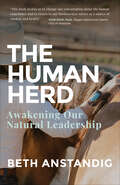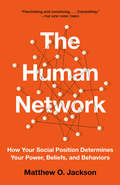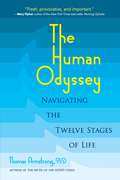- Table View
- List View
The Household: Informal Order around the Hearth
by Robert C. EllicksonSome people dwell alone, many in family-based households, and an adventuresome few in communes. The Household is the first book to systematically lay bare the internal dynamics of these and other home arrangements. Legal underpinnings, social considerations, and economic constraints all influence how household participants select their homemates and govern their interactions around the hearth. Robert Ellickson applies transaction cost economics, sociological theory, and legal analysis to explore issues such as the sharing of household output, the control of domestic misconduct, and the ownership of dwelling units. Drawing on a broad range of historical and statistical sources, Ellickson contrasts family-based households with the more complex arrangements in medieval English castles, Israeli kibbutzim, and contemporary cohousing communities. He shows that most individuals, when structuring their home relationships, pursue a strategy of consorting with intimates. This, he asserts, facilitates informal coordination and tends ultimately to enhance the quality of domestic interactions. He challenges utopian critics who seek to enlarge the scale of the household and legal advocates who urge household members to rely more on written contracts and lawsuits. Ellickson argues that these commentators fail to appreciate the great advantages in the home setting of informally associating with a handful of trusted intimates. The Household is a must-read for sociologists, economists, lawyers, and anyone interested in the fundamentals of domestic life.
The Housing Crisis
by Peter MalpassOriginally published in 1986 at a time when Britain was facing a major housing crisis, this book, containing much original research, examines the crisis and analyses the reasons for it, providing foundations for the construction of effective new policies. As relevant now as when it was first published the book discusses under investment in housing stock, in both the public and private sectors, renovation and maintenance and neglect of particular disadvantaged groups such as the elderly, the single homeless and those in low income groups.
The Housing Divide
by Samantha Friedman Emily RosenbaumThe Housing Divide examines the generational patterns in New York City's housing market and neighborhoods along the lines of race and ethnicity. The book provides an in-depth analysis of many immigrant groups in New York, especially providing an understanding of the opportunities and discriminatory practices at work from one generation to the next. Through a careful read of such factors as home ownership, housing quality, and neighborhood rates of crime, welfare enrollment, teenage pregnancy, and educational achievement, Emily Rosenbaum and Samantha Friedman provide a detailed portrait of neighborhood life and socio-economic status for the immigrants of New York. The book paints an important, if disturbing, picture. The authors argue that not only are Blacks—regardless of generation—disadvantaged relative to members of other racial/ethnic groups in their ability to obtain housing in high-quality neighborhoods, but that housing and neighborhood conditions actually decline over generations. Rosenbaum and Friedman's findings suggest that the future of racial inequality in this country will increasingly isolate Blacks from all other groups. In other words, the “color line” may be shifting from a line separating Blacks from Whites to one separating Blacks from all non-Blacks.
The Housing and Economic Experiences of Immigrants in U.S. and Canadian Cities
by Wei Li Carlos TeixeiraSince the 1960s, new and more diverse waves of immigrants have changed the demographic composition and the landscapes of North American cities and their suburbs. The Housing and Economic Experiences of Immigrants in U.S. and Canadian Cities is a collection of essays examining how recent immigrants have fared in getting access to jobs and housing in urban centres across the continent.Using a variety of methodologies, contributors from both countries present original research on a range of issues connected to housing and economic experiences. They offer both a broad overview and a series of detailed case studies that highlight the experiences of particular communities. This volume demonstrates that, while the United States and Canada have much in common when it comes to urban development, there are important structural and historical differences between the immigrant experiences in these two countries.
The Hubris Hazard, and How to Avoid It
by Eugene Sadler-SmithHubris is something we’ve all seen in action and experienced all too often. It’s a significant occupational hazard and a serious potential derailment factor for leaders, organisations, and civil society. Hubristic leaders - intoxicated as they are with power, praise, and success–behave in ways that, if left unchecked, invite unintended and unforeseen negative consequences which impact destructively on individuals, industries, economies, and nations.Despite numerous examples throughout history of hubris’ destructive consequences, it nonetheless appears to be an ever-present and growing danger. Many leaders seem to be blind to the hazards of hubris and oblivious to the lessons of history. Prevention is better than cure and understanding the nature of the hubris hazard and the associated risk factors will help leaders and managers improve their personal performance and avoid derailment and, even more importantly, protect the well-being of employees and the resilience of their organisations over the long term. This book explains the characteristics, causes, and consequences of hubris, and shows how to combat the significant hazard it poses to managers, leaders, organisations, and society. With contemporary examples, each chapter explores a particular ‘hubris risk factor’ and shows how the risk can be managed and mitigated and exposure to the hubris hazard minimised.The Hubris Hazard, and How to Avoid It offers practical guidance and action points for managers and leaders on how to recognise hubris in themselves and others and what to do to combat it when it arises. It will also be useful for business and executive coaches and leadership trainers and developers.
The Humachine: AI, Human Virtues, and the Superintelligent Enterprise
by Nada R. Sanders John D. WoodUpdated for a post-Covid world, the second edition of this groundbreaking book explains why becoming a Humachine enterprise is the only way forward for a company to maintain a competitive advantage in the age of artificial intelligence (AI).The first edition of The Humachine offered a foundation for a new form of enterprise, integrating AI technology and human resources to optimize the unique advantages possessed by each. Now, in the face of the ‘Great Resignation’ and ‘botsourcing’—where an activity previously done by humans is replaced by technology—thought leaders Sanders and Wood present a more positive and promising scenario, where an enterprise recognizes human resources as an asset class that possesses skills that cannot be replaced by automation. Enlightened business leaders will look to create synergy between technology and people, enabling the organization to maximize its capabilities by elevating the basis of decision making with closer-to-perfect information and rationality. This book provides a roadmap for how to do this and achieve collective intelligence at the enterprise level: superintelligence. More specifically, it answers these questions, and more. Why must an enterprise achieve superintelligence as a competitive advantage in the age of AI? How can any organization achieve superintelligence by following the 4-I model? What is the step-by-step process an enterprise should follow in becoming a Humachine? What strategies can be used by enterprise leaders to ‘futureproof’ the Humachine against uncertainty? All business leaders, executives, and managers at companies wanting to use AI and technology to survive and thrive in this new age, and students of analytics and decision-making, will value this thought-provoking and practical book, rich with case studies.
The Humachine: Humankind, Machines, and the Future of Enterprise
by Nada R. Sanders John D. WoodThere is a lot of hype, hand-waving, and ink being spilled about artificial intelligence (AI) in business. The amount of coverage of this topic in the trade press and on shareholder calls is evidence of a large change currently underway. It is awesome and terrifying. You might think of AI as a major environmental factor that is creating an evolutionary pressure that will force enterprise to evolve or perish. For those companies that do survive the "silicon wave" sweeping through the global economy, the issue becomes how to keep their humanity amidst the tumult. What started as an inquiry into how executives can adopt AI to harness the best of human and machine capabilities turned into a much more profound rumination on the future of humanity and enterprise. This is a wake-up call for business leaders across all sectors of the economy. Not only should you implement AI regardless of your industry, but once you do, you should fight to stay true to your purpose, your ethical convictions, indeed your humanity, even as our organizations continue to evolve. While not holding any punches about the dangers posed by overpowered AI, this book uniquely surveys where technology is limited, and gives reason for cautious optimism about the true opportunities that lie amidst all the disruptive change currently underway. As such, it is distinctively more optimistic than many of the competing titles on Big Technology. This compelling book weaves together business strategy and philosophy of mind, behavioral psychology and the limits of technology, leadership and law. The authors set out to identify where humans and machines can best complement one another to create an enterprise greater than the sum total of its parts: the Humachine. Combining the global business and forecasting acumen of Professor Nada R. Sanders, PhD, with the legal and philosophical insight of John D. Wood, Esq., the authors combine their strengths to bring us this profound yet accessible book. This is a "must read" for anyone interested in AI and the future of human enterprise.
The Human Algorithm
by Robin K. MathewIn today&’s hyperconnected world, our lives have become increasingly intertwined with the technology we interact with. While innovations like smartphones and the Internet have brought unprecedented convenience and connectivity, they have also introduced new risks and challenges.In The Human Algorithm, Dr Robin K. Mathew takes readers on an eye-opening exploration of the complex digital landscape and our ever-evolving engagement with it. With chapters delving into smartphone addiction, the impact of technology on cognitive development, threats such as cyberbullying, online predators, and the dark web, this book shines a revelatory light on the often-overlooked aspects of our online existence. This comprehensive work also dedicates chapters to the internet&’s role in fuelling anxiety and hypochondria, the emergence of cyber dating and romance, and the potential of artificial intelligence (AI), among other crucial topics.All in all, this richly researched and compellingly argued compendium will equip you with the knowledge and insights to navigate the digital age with awareness and resilience.
The Human City: Urbanism for the Rest of Us
by Joel KotkinThe author of The Coming of Neo-Feudalism and The New Class Conflict challenges conventions of urban planning. Around the globe, most new urban development has adhered to similar tenets: tall structures, small units, and high density. In The Human City, Joel Kotkin―called &“America&’s uber-geographer&” by David Brooks of the New York Times―questions these nearly ubiquitous practices, suggesting that they do not consider the needs and desires of the vast majority of people. Built environments, Kotkin argues, must reflect the preferences of most people―even if that means lower-density development. The Human City ponders the purpose of the city and investigates the factors that drive most urban development today. Armed with his own astute research, a deep-seated knowledge of urban history, and a sound grasp of economic, political, and social trends, Kotkin pokes holes in what he calls the &“retro-urbanist&” ideology and offers a refreshing case for dispersion centered on human values. This book is not anti-urban, but it does advocate a greater range of options for people to live the way they want at all stages of their lives.Praise for The Human City &“Kotkin . . . presents the most cogent, evidence-based and clear-headed exposition of the pro-suburban argument . . . . In pithy, readable sections, each addressing a single issue, he debunks one attack on the suburbs after another. But he does more than that. He weaves an impressive array of original observations about cities into his arguments, enriching our understanding of what cities are about and what they can and must become.&” —Shlomo Angel, Wall Street Journal &“The most eloquent expression of urbanism since Jane Jacobs&’s The Death and Life of Great American Cities. Kotkin writes with a strong sense of place; he recognizes that the geography and traditions of a city create the contours of its urbanity.&” —Ronnie Wachter, Chicago Tribune
The Human Cloud: How Today's Changemakers Use Artificial Intelligence and the Freelance Economy to Transform Work
by Matthew Mottola Matthew Douglas CoatneyEmpower yourself with the knowledge to keep up with the rapidly changing technical world of work, as two workforce productivity and technology experts lay out a clear picture of the?coming?revolution?in how work is done and how jobs are shaped.If you listen to the news, robots are coming for your job. Full-time employment will soon be a thing of the past as organizations opt more to hire employees on a contract basis.?With technological advances across email, video, project management, and instant messaging platforms, being tied to a desk working full time for one company is becoming obsolete. So, where does that leave you?The Human Cloud may be the most important book you read to prepare for how work is done in the future. In these pages, human cloud technologist Matthew Mottola and AI expert Matthew Coatney help you not only clearly understand the transition you see happening around you, but they will also help you take advantage of it.In The Human Cloud, Mottola and Coatney inform you about topics including:How employees and employers will be able to take advantage of the new automated and freelance-based workplace.How they will be able to take advantage of the new technology disruptions the machine cloud will create.Why the changes employees and employers are seeing aren&’t the projection of doom that many are predicting.How to navigate the coming job marketplace.By replacing fear with knowledge, you will better understand how this shift in employment is a good thing, be equipped to embrace the positive?advantages new technology brings, and further secure how your own job is shaped so you are never left behind.
The Human Condition
by Hannah ArendtA work of striking originality bursting with unexpected insights, "The Human Condition" is in many respects more relevant now than when it first appeared in 1958. In her study of the state of modern humanity, Hannah Arendt considers humankind from the perspective of the actions of which it is capable. The problems Arendt identified then --- diminishing human agency and political freedom, the paradox that as human powers increase through technological and humanistic inquiry, we are less equipped to control the consequences of our actions --- continue to confront us today.
The Human Condition: Second Edition
by Hannah ArendtThe renowned political thinker and author of The Origins of Totalitarianism examines the troubling consequences of humanity’s increasing power.A work of striking originality, The Human Condition is in many respects more relevant today than when it first appeared in 1958. In her study of the state of modern humanity, Hannah Arendt considers humankind in terms of its ever-expanding capabilities. Her analysis reveals a troubling paradox: that as human powers increase through technological and humanistic inquiry, we are less equipped to control the consequences of our actions. This new edition contains Margaret Canovan’s 1998 introduction and a new foreword by Danielle Allen. A classic in political and social theory, The Human Condition offers a penetrating analysis of a conundrum that has only become more acute in the 21st century.
The Human Constraint: How Business Leaders Can Embed Continuous Innovation, Conflict Resolution, and Problem Solving Into Daily Practice
by Angela MontgomeryThe Human Constraint is a business novel with supplementary material for business leaders. It is inspired by dozens of implementations of the Decalogue methodology in Europe and North America since 1996. The Decalogue blends Deming’s philosophy with the Theory of Constraints in a cohesive, systemic approach to management. The novel explores an increasingly complex, interdependent and fast-changing world where companies must have a way to overcome obsolete mental models and embed continuous innovation in their operations with a coherent organizational model.The story in Part One unfolds during the financial crisis that follows 2008 and illustrates how this affects a group of executives engaged in a transformation process. It charts their attempts through the crisis to transform part of an industry dominated by a zero-sum game mentality using a very different approach: an ethical and value-based supply chain where all stakeholders benefit.Through the narrative in Part One, readers are exposed to a way to embed continuous innovation, conflict resolution, and problem-solving in action. In Part Two readers will find an introduction to a systemic method for management and the Thinking Processes from the Theory of Constraints.These Thinking Processes can help readers develop the skills to:■ Understand and analyze our current reality, as individuals and organizations.■ Surface assumptions that keep us trapped in less-than-desirable situations.■ Generate robust solutions/innovations.■ Identify unintended consequences of what may seem like an effective idea and avert them upstream.■ Resolve conflicts in a win-win way.The knowledge, method, and tools to overcome obsolete mental models and practices exist. This book aims to present the reader, through narrative and supplementary material, with elements of a new way and a new economics that are fit for purpose in our age of complexity.
The Human Cost of African Migrations (African Studies #1)
by Toyin Falola Niyi AfolabiIn an era of globalization, population growth, and displacements, migration is now a fact of life in a constantly shifting economic and political world order. This book contributes to the discourse on the beneficiaries, benefactors, and the casualties of African displacement. While the few existing studies have emphasized economic motivation as the primary factor triggering African migration, this volume treats a range of issues: economic, socio-political, pedagogical, developmental, and cultural. Organized with a multidisciplinary thrust in mind, this book argues that any discussion of African migration, whether internal or external, must be conceived as only one aspect of a more complex, organic, and global patterning of "flux and reflux" necessitated by constantly shifting dynamics of world socio-economic, cultural, and political order.
The Human Experience: The Early Years (Routledge Revivals)
by Cedric CullingfordFirst published in 1999, the focus of this ground-breaking study is on representing the mental world of the child with unprecedented clarity. Cedric Cullingford aims to show that this world, in its normal experience by children, is significantly unlike what we typically assume it to be, and significantly unlike anything exposed by the most prominent research programs. Querying common assumptions about children’s thinking, Cullingford begins with an outline of children’s understanding which emphasizes its range and complexity, along with an address of the mythology of children’s intellectual incapacity and preparation for the approach to be taken in detailing children’s construction of a sense of their world. The following four chapters combine to construct a description of how children approach their world, exploring theory of mind, the self, the family, the school and then the wider social and physical worlds. Cullingford achieves a vividness, immediacy and intensity not seen elsewhere, using the constant medium of the child’s gaze and demonstrating that the youngest child is not simply responsive but is active and critical in interrogating the world.
The Human Face of Global Mobility (Comparative Urban And Community Research Ser. #Vol. 8)
by Michael Peter Smith Favell AdrianAlongside flows of trade and capital, the free movement of professionals, technical personnel, and students is seen as a key aspect of globalization. Yet not much detailed empirical research has been completed about the trajectories and experiences of these highly skilled or highly educated international migrants. What little is known about these forms of "global mobility," and the politics that surround them, contrasts with the abundant theories and accounts of other types of international migration--such as low income economic migration from less developed to core countries in the international political economy. Drawing on the work of a long-standing discussion group at the Center for Comparative and Global Research of UCLA's International Institute, this collection bridges conventional methodological divides, bringing together political scientists, sociologists, demographers, and ethnographers. It explores the reality behind assumptions about these new global migration trends. It challenges widely held views about the elite characteristics of these migrants, the costs and consequences of the brain drain said to follow from the migration of skilled workers, the determinants of national policies on high skilled migrants, and the presumed "effortlessness" of professional mobility in an integrating world. The volume also sheds new light on international student migration, the politics of temporary, non-immigrant workers in the United States, new international forms of regulating movement, and the realities of the everyday lives of multinational employees in the world's transnational cities. Key differences between the regional contexts of this migration in Europe, North America, and the Asia-Pacific are also emphasized.
The Human Factor in a Mission to Mars: An Interdisciplinary Approach (Space and Society)
by Konrad SzocikA manned mission to Mars is faced with challenges and topics that may not be obvious but of great importance and challenging for such a mission. This is the first book that collects contributions from scholars in various fields, from astronomy and medicine, to theology and philosophy, addressing such topics. The discussion goes beyond medical and technological challenges of such a deep-space mission. The focus is on human nature, human emotions and biases in such a new environment.The primary audience for this book are all researchers interested in the human factor in a space mission including philosophers, social scientists, astronomers, and others. This volume will also be of high interest for a much wider audience like the non-academic world, or for students.
The Human Factor of Cybercrime (Routledge Studies in Crime and Society)
by Thomas J. Holt Rutger LeukfeldtCybercrimes are often viewed as technical offenses that require technical solutions, such as antivirus programs or automated intrusion detection tools. However, these crimes are committed by individuals or networks of people which prey upon human victims and are detected and prosecuted by criminal justice personnel. As a result, human decision-making plays a substantial role in the course of an offence, the justice response, and policymakers' attempts to legislate against these crimes. This book focuses on the human factor in cybercrime: its offenders, victims, and parties involved in tackling cybercrime. The distinct nature of cybercrime has consequences for the entire spectrum of crime and raises myriad questions about the nature of offending and victimization. For example, are cybercriminals the same as traditional offenders, or are there new offender types with distinct characteristics and motives? What foreground and situational characteristics influence the decision-making process of offenders? Which personal and situational characteristics provide an increased or decreased risk of cybercrime victimization? This book brings together leading criminologists from around the world to consider these questions and examine all facets of victimization, offending, offender networks, and policy responses.
The Human Factor: How to Realize the Potential of your People and your Business
by Michael Esau Simon HumphreysDevelop and leverage the human factor in your workforce and organization to boost individual and business performance. This book explores what the human factor is and how it influences the attraction, performance, retention, growth, productivity and wellbeing of employees. It also explains how focusing on it at all levels of the organization can boost both individual and business performance. It's a roadmap to success for all senior HR professionals, organizational development practitioners, managers and leaders. There is detailed discussion of sustainability, technology, analytics and organizational change, as well as a framework for building a case for change. The book also provides guidance on how to define organizational purpose, develop an effective organizational culture and how to design and execute a people strategy. There is also discussion of human motivation, the role it plays for individuals and leaders and the need for continual improvement of staff at all levels. Written by an expert author team with more than 50 years' experience between them, the book explains why the human factor is so important and how the changing context in which we live and work demands that HR professionals evolve to stay relevant.
The Human Group (International Library Of Sociology Ser.)
by George Caspar HomansGeorge C. Homans's classic volume The Human Group was among the first to study the small group as a microcosm of society. It introduced a method of analysis and a set of influential theories that cut across areas of specialization on the personality, community, and industry.The study of even the smallest groups is extremely complex, with the simplest associations involving an abundance of actions, relationships, emotions, motives, ideas, and beliefs. Homans concentrates on certain activities and processes he observes in five carefully selected and differentiated case studies and from them draws common patterns and ideas that serve as the bases of testable propositions.He divides his cases into static and dynamic groups. In all five cases, Homans selects comparable phenomena for analysis with a contextually different emphasis and elaboration each time. His results demonstrate that, different as these groups are, their behavior reveals fundamental similarities and social uniformities. A ground-breaking and authoritative work when it was first published in 1950, The Human Group continues to Inform and invigorate the study of small groups in sociology, psychology, management, and organizations.
The Human Group (International Library of Sociology)
by George C. HomansPublished in 1998, The Human Group is a valuable contribution to the field of Sociology and Social Policy.
The Human Hand as an Inspiration for Robot Hand Development
by Ravi Balasubramanian Veronica J. Santos"The Human Hand as an Inspiration for Robot Hand Development" presents an edited collection of authoritative contributions in the area of robot hands. The results described in the volume are expected to lead to more robust, dependable, and inexpensive distributed systems such as those endowed with complex and advanced sensing, actuation, computation, and communication capabilities. The twenty-four chapters discuss the field of robotic grasping and manipulation viewed in light of the human hand's capabilities and push the state-of-the-art in robot hand design and control. Topics discussed include human hand biomechanics, neural control, sensory feedback and perception, and robotic grasp and manipulation. This book will be useful for researchers from diverse areas such as robotics, biomechanics, neuroscience, and anthropologists.
The Human Herd: Awakening Our Natural Leadership
by Beth AnstandigThe Human Herd is a guidebook that helps readers unleash their mammal instincts and shows them how to heighten their self-awareness, experience their lives more deeply, improve their relationships, and step into a more natural—and powerful—way to lead.
The Human Network: How Your Social Position Determines Your Power, Beliefs, and Behaviors
by Matthew O. JacksonHere is a fresh, intriguing, and, above all, authoritative book about how our sometimes hidden positions in various social structures—our human networks—shape how we think and behave, and inform our very outlook on life.Inequality, social immobility, and political polarization are only a few crucial phenomena driven by the inevitability of social structures. Social structures determine who has power and influence, account for why people fail to assimilate basic facts, and enlarge our understanding of patterns of contagion—from the spread of disease to financial crises. Despite their primary role in shaping our lives, human networks are often overlooked when we try to account for our most important political and economic practices. Matthew O. Jackson brilliantly illuminates the complexity of the social networks in which we are—often unwittingly—positioned and aims to facilitate a deeper appreciation of why we are who we are.Ranging across disciplines—psychology, behavioral economics, sociology, and business—and rich with historical analogies and anecdotes, The Human Network provides a galvanizing account of what can drive success or failure in life.
The Human Odyssey: Navigating the Twelve Stages of Life
by Thomas Armstrong"This is truly a major contribution — brilliant, beguiling, and as broad in concept as it is deep." — Jean Houston, PhD, author of The Possible HumanThomas Armstrong, Ph.D., an award-winning educator and expert on human development, offers a cross-cultural view of life's entire journey, from before birth to death to the possibilities of an afterlife. Dr. Armstrong cites both clinical research and anecdotal evidence in a comprehensive view of the challenges and opportunities we face at every stage of our development. His accessible narrative incorporates elements of history, literature, psychology, spirituality, and science in a fascinating guide to understanding our past as well as our future."I loved the tone, the pacing, the sense of audience, and especially the richness of the associations . . . It's a book that one would like to keep around — a guidebook even." — John Kotre Ph.D., co-author of Seasons of Life: The Dramatic Journey from Birth to Death "The Human Odyssey is superb, magnificent, astonishing, unique, engrossing, eminently readable, informative, enjoyable, entertaining, profound. What else? I could go on. I hadn't expected anything like so remarkable a book." — Joseph Chilton Pearce, author of The Crack in the Cosmic Egg and Magical Child "I have read through The Human Odyssey. It is in many ways impressive. I also think that it has great commercial potential. Many people will find attractive your dual focus on the scientific and the soul/spiritual dimensions." — Howard Gardner, Ph.D., The John H. and Elizabeth A. Hobbs Professor in Cognition and Education at the Harvard Graduate School of Education, author of Frames of Mind "I extend my congratulations to you for this monumental undertaking and wish you the very best for your impressive efforts." — Marian Diamond, Ph.D. Professor, Department of Integrative Biology, University of California, Berkeley; co-author of Magic Trees of the Mind; pioneer researcher into the effect of the environment on brain development; dissected Einstein's brain "I very much enjoyed The Human Odyssey. Your breadth of sources is remarkable, and you have put them all together in a smooth and integrative way. I think it will be informative for people, and also inspiring for them to make their stages of life more meaningful. Overall, this is an impressive tour de force." — Arthur Hastings, Ph.D., Professor and Director, William James Center for Consciousness Studies, Institute of Transpersonal Psychology; Past President, Association of Transpersonal Psychology "Extraordinary. I hope that it is read by many people." — Laura Huxley, widow of Aldous Huxley, founder of Children: Our Ultimate Investment, and author of This Timeless Moment, and The Child of Your Dreams "A wonderful and encyclopedic summary of human development." — Allan B. Chinen, M.D., Clinical Professor of Psychiatry, University of California, San Francisco; author of Once Upon a Mid-Life: Classic Stories and Mythic Tales to Illuminate the Middle Years and In the Ever After: Fairy Tales and the Second Half of Life "Absolutely remarkable. The Human Odyssey is written with lively scholarship and contains great depth and breadth, a wide range of fascinating materials, and many useful resources. It's a kind of 'everything book.'" — George Leonard, "the granddaddy of the consciousness movement" (Newsweek) and author of The Transformation and The Ultimate Athlete"The Human Odyssey provides readers with a fresh approach to developmental psychology. Dr. Armstrong has included a spiritual dimension of human growth that is lacking from most accounts but which is essential for a complete understanding of the human condition. It is a splendid, brilliant work." — Stanley Krippner, Ph.D., former president of the Association for Humanistic Psychology, author of Personal Mythology: The Psychology of Your Evolving Self, and co-editor of The Psychological Impact of War Trauma on Civilians: An International Perspective "An integral approach to human development, from birth to death, that provides practical information for all who
